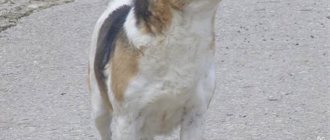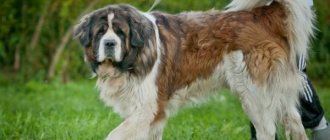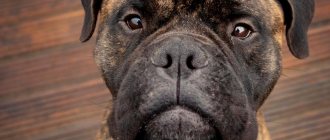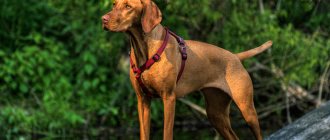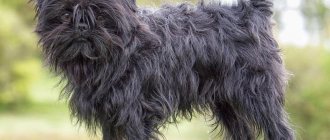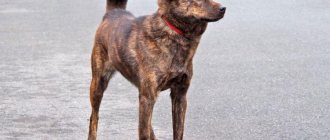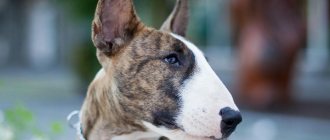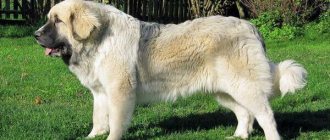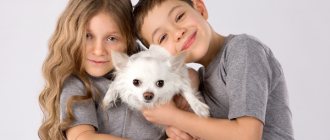Video
* We invite you to watch a video about the Pekingese . In fact, in front of you is a playlist in which you can select and watch any of 20 videos about a given dog breed by simply clicking on the button in the upper right corner of the window. In addition, the material contains quite a lot of photos. By looking at them you can find out what a Pekingese looks like.
In this article:
|
Rate the material!
[Total votes: 1 Average: 5]
The Pekingese is a compact toy companion with a regal bearing and a distinctive agile gait. It is one of several breeds created for the ruling classes of ancient China. Pekingese are charming, confident dogs that develop a close bond with their loved one. Raised for life in palaces, they can be as serene as the emperors who owned them.
The legend of the origin of the Pekingese
One of the legends tells an unusual story of the origin of Pekingese (Peking dogs).
This is a story about the love of the king of animals, a lion, and a cute monkey.
The monkey was very touched that the lion himself paid attention to her, but still refused him. And this was only due to the large difference in size.
She is a small, fragile monkey, and he is a proud master of the beasts. Trying to soften his answer, the monkey offered the lion strong friendship.
Photo 4. Adorable Pekingese puppy
Leo was very upset, and his melancholy did not give him peace for a long time.
To find out how to rid himself of these mental torments, the lion asked an old man in his native forest.
The old man was a monk and understood the language of animals well and asked the lion if he could give up his strength and his size in order to be able to be on an equal footing with his beloved.
Of course, the lion in love was ready to sacrifice everything for the monkey. And he agreed.
A mysterious spell whispered by the old man shrunk the lion and took away most of his royal power.
However, this heroic act did not go unnoticed by the monkey, and she gave her consent to the lion.
After some time, they got married, and soon the first little dog was born - the fruit of the love of a lion and a monkey.
This dog has absorbed the lion's pride and nobility, as well as his courage and calmness. And these dogs inherited smart eyes and the ability to show pertness from that same monkey...
Representatives of this breed were favorite pets of eastern aristocrats and royal families. Pekingese were bred and raised as sacred animals in Buddhist temples.
No other Chinese pet has received the honor of being depicted so often in artists' paintings. There are many references to the Pekingese in the literature.
History of the origin of the Pekingese
Chinese legend says that one day a lion fell in love with a monkey. In order to marry her, he asked the Buddha to make him smaller but allow him to retain his great lion's heart and character. Buddha agreed, and from this union came the Pekingese, the lion dog of China.
This may not be a completely true story, but it is interesting. The breed is truly ancient; DNA analysis confirmed it as one of the oldest dog breeds. Named after the capital Beijing, they were companions of nobles, princes and members of the imperial family.
The Pekingese was carefully guarded and could never leave the palace, let alone the country. He came to the attention of the Western world as a result of the War of 1860. After British troops invaded Beijing, five Pekingese dogs were found in the imperial palace guarding the body of a woman who had committed suicide. The dogs became trophies of that war and were taken to England. Two of them were given to the Duchess of Wellington, two more to the Dukes of Richmond and Gordon, and one to Queen Victoria, who named him Lootie.
They were still a rare breed, although by the 1890s many Pekingese were being smuggled out of Beijing. The Pekingese Club was founded in 1904. Naturally, the breed's popularity spread across the Atlantic to the United States. The first Pekingese registered by the American Kennel Club was Rascal in 1906.
Six years later, the breed made headlines when the Pekingese was one of three dogs to survive the sinking of the Titanic. In 1909, the Pekingese Club of America was formed. Today this breed ranks 49th out of 155 breeds.
Pekingese - description of the breed
The Pekingese is a well-balanced, compact dog of Chinese origin with heavy front legs and lighter hind legs. The Pekingese is the very spontaneity, independence and individuality. His image is similar to a lion and implies courage and self-esteem rather than weakness and delicacy.
Pekingese have very distinct, wrinkled, flat faces, which, although adorable, often cause breathing and eye problems in the breed. The Pekingese's head is large in relation to the body and quite wide. Their noses are short and have wide open nostrils. Wrinkles run from the cheeks to the bridge of the nose, which forms an inverted “V”.
Their eyes are round, clear and have a wonderful dark shine. The Pekingese's ears boast a copious amount of fur, which adds to the breed's attractiveness. The dogs' necks are quite thick and relatively short, the front legs are stronger than the hind legs and thick. Their shoulders are well relaxed and fit perfectly into the dog's body.
The Pekingese has a fairly short body and a defined waist. Their ribs are well sprung, with a good topline. The hind legs are muscular and strong, although slightly lighter than the front legs. The Pekingese's feet are quite flat and large, with the front feet often slightly curved and the back feet pointing straight ahead. Their tails are set high and the dogs have slightly arched backs and sometimes carry their tail to one side. Pekingese tails are beautifully decorated with fur.
Brief description of the breed
The Pekingese is an imperial breed. Previously, only the nobility had such animals. If such a dog was stolen, the attacker was punished by execution. The breed comes from Beijing (hence its name).
Appearance standards:
- Large head with a flattened and wide skull.
- Big round eyes.
- Black eyelids.
- Flat muzzle with black nose.
- Heart-shaped ears with elongated hair.
- Thick and short neck.
- The front part of the body is powerful, developed chest.
- Slim waist.
- Flattened and crooked paws.
- High-set tail with thick, long hair.
- Weight – from 2.5 to 5.5 kg.
- Dense undercoat.
- Height at the withers is 10-25 cm.
The traditional color is red. But there are animals with black, sandy, white, gray or spotted fur.
Dogs are distinguished by high intelligence, good nature, fearlessness and activity. They are friendly and loyal to their owners. But they are characterized by arrogance and stubbornness.
Popular Pekingese colors
The Pekingese has long, coarse, straight hair that sits away from the body like a fluffy halo. Beneath the top coat there is a thick, soft undercoat. Consistent with its description as a lion dog, the Pekingese has a prominent mane on the neck and shoulders, with somewhat shorter hair on the rest of the body. Although it should be long and abundant, the coat should not obscure the shape of the body. Long hair is found on the back of the feet and on the toes, with longer edging on the ears and tail.
Wool can be of different colors and have any patterns. Pekingese can be black, red, fawn, red, brindle, and also partially colored, such as white with another color. He may or may not have a black mask. The white Pekingese was highly prized by the Chinese and is still quite popular today. Regardless of coat color, the exposed skin of the muzzle, nose, lips and eyes always remains black.
The accepted colors of the breed, registered in kennel clubs, are:
- Black;
- Black-brown;
- Black and white;
- Tiger-black;
- Cream;
- Creamy black;
- Fawn black;
- Fawn brindle;
- Black-fawn-brindle;
- Gray brindle;
- Light red;
- Red;
- Red-black;
- Red brindle;
- Red-tiger-black;
- Red-fawn-black;
- Silver;
- Silver brindle;
- Silver-fawn-black;
- White.
You can clean your Pekingese's coat weekly using a small bristle brush or combing. Before combing, lightly moisten the comb or brush with water to prevent the hair from breaking. The comb should be completely adjacent to the skin. Simply walking over the top of the coat will not get rid of the dead hair that forms mats and balls. A metal comb should be used on the feathering and edging on the feet, ears and tail. These areas get tangled easily, so they should be brushed daily.
Important fact: It is necessary to trim the hair on the paws to prevent the development of mats and foreign objects from getting into them. Nails should be trimmed regularly, usually every two or three weeks. If you can hear them clicking on the floor, they are too long.
Smooth-haired and long-haired
Based on their coat type, Pekingese dogs are divided into two types::
- Longhair (standard) . The guard hair is straight, of medium length, the undercoat is soft to the touch and quite thick. Females have a luxurious collar on their neck. Males have a lion's mane. On the hind legs the fur forms soft trouser legs, and on the front legs there are noticeable fringes. The fur is longest on the ears and tail.
- Smooth-haired or short-haired . Officially, this type of breed does not exist, but sometimes there are representatives with shorter fur than usual. For example, the black and white Pekingese. Their coat is of medium length, without a thick undercoat. There are no featherings on the ears, but the tail is still the fluffiest part of the body.
Often, under the guise of short-haired Pekingese, sellers offer outbred dogs, crosses with a spaniel, chin or other breeds of similar type.
Character and habits of the Pekingese
He may look funny, but the Pekingese is a serious character, tougher and braver than his appearance suggests. The regal dignity, self-esteem, confidence and stubbornness of the Pekingese are contained in a lively and good-natured dog that respects its owner. He staunchly protects people, barking in warning when strangers appear. It needs to be trained firmly but kindly, using positive reinforcements such as food rewards and praise. It is easy to succeed if you convince your Pekingese that doing something is his idea, not his owner's.
The Pekingese's temperament is influenced by a number of factors, including heredity, training and socialization. Puppies with a good temperament are curious and playful, willing to approach people and bond with them. Pekingese do not always get along with other dogs. They prefer the company of other Pekingese and may take a long time to get used to other pets. Like any dog, Pekingese dogs need early socialization—exposure to many different people, sights, sounds, and experiences—when they are young. Socialization helps ensure that the puppy grows up to be sociable and well-mannered.
The Pekingese is very loving and affectionate with its family, but wary with strangers. This characteristic makes them excellent guard dogs. They love to bark when strangers approach. Some Pekingese have a tendency to bark too much, so it's a good idea to teach them when to stop. They are brave, sometimes very reckless, and will defend their owner to the death if necessary.
The Pekingese will greet its owner with dignity and pride. He is well aware that his ancestors were companions of the royal family, and continues to demand respect. He is fully aware of who he is and what he means to the people who live with him.
Purpose and character of the Pekingese
The Pekingese will make an excellent friend and companion; these dogs become very attached to their owner. True, then you may encounter such a phenomenon as jealousy; Pekingese do not like to share “their person” with anyone else. This breed is suitable for everyone, but small children should be careful with a puppy, and even an adult dog, so as not to injure it. By nature, Pekingese are quite calm, not aggressive, but fearless; the pet must be protected from danger. They are proud, selfish, wayward. Pekingese are smart and well-mannered, but you should not rely only on character and neglect training, otherwise you will become a servant of the imperial dog.
Pekingese are not only jealous, but also touchy; they can be hurt by inattention, lack of affection, or the manifestation of feelings towards another animal or person. We will have to try to return him to his former cheerful mood. Dogs are aristocratic, this is both a plus and a minus of the breed. On the one hand - refined manners, dignified behavior, on the other - pickiness and capriciousness. Be prepared for the fact that dogs of this breed snore quite loudly and sneeze often, this is due to brachycephaly - a short muzzle.
1 of 11
Interesting facts about Pekingese
The Pekingese is an ideal companion for an elderly person and prefers to live in a home with only one adult rather than in a home with many small children. The Pekingese is a good choice for first-time owners, although anyone who wants to share their home with one of these adorable little dogs must be prepared to devote a lot of time to keeping their coat in good condition.
The Pekingese is not a good choice for families with toddlers who may be rough with them without thinking about it. The Pekingese will not tolerate being grabbed and will not hesitate to defend itself.
Children should always be taught how to approach and touch dogs. Supervise any interactions between dogs and small children. A child should never approach any dog while it is sleeping or eating, or try to take the dog's food. No dog should be left unattended with a child.
Pekingese prefer the company of other Pekingese, but with early socialization they can learn to get along with other dogs (and cats) and can even handle dogs 20 times their size. Pekingese are very adaptable dogs if they are given enough daily exercise combined with plenty of mental stimulation to prevent boredom.
Pekingese enjoy cold temperatures. Raised to endure Beijing's long, cold winters, Pekingese thrive when temperatures drop. Some Pekingese owners even travel with ice packs to keep their pups comfortable.
Some Pekingese love to swim and take to the water whenever possible, especially in hot weather. However, since they have such long, dense coats and short muzzles, caution should always be used when Pekingese decide to go into the water. Their heavy coat can pull them down and they may have trouble breathing because they are a brachycephalic breed.
Pros and cons of Pekingese
The Pekingese is a smart dog that knows how to play with its charm. The Pekingese is very attached to its owner and is little inclined to accept people who are strangers to its family. That is why, despite its small size, it is a good watchman who knows how to warn its owner in case of a home invasion. The brave Pekingese is not shy about competing with other dogs, even larger ones, to defend its territory.
Pekingese are very strong-willed. Pekingese owners often describe their pets as “self-confident.” Maybe it also has to do with their royal heritage: these dogs are smart, they know their minds and are not afraid to express their feelings. Obedience classes are a good way to ensure that those leonine qualities don't develop into stubbornness.
Fun fact: The Pekingese can be a good guard dog. In ancient China, the smallest Pekingese with a fierce temperament was kept in the sleeves of royalty and used as miniature guard dogs. These Pekingese traits were not lost. Owners often report that their pets alert to intruders or other suspected dangers.
The Pekingese, with its strong character, is not a very obedient dog. He must be taught firmly enough so that he can respect the orders of his master. An attentive, kind but firm teacher is ideal for the Pekingese. This is why this dog is good for older people. On the other hand, he doesn't really appreciate the company of children. Aggression is the Pekingese's reaction to roughness and force, so you need to be careful with this. The best way to punish is to ignore them, because Pekingese do not like to be alone.
The Pekingese coat requires special care. The Pekingese needs to be brushed several times a week and needs an occasional bath - if not taken care of, the fur can become matted. Some Pekingese owners also trim the fur over the eyes to aid the dog's vision and, in hot weather, for the dog's comfort. The Pekingese also sheds seasonally.
Pekingese need daily exercise, but it will not tire out its owner. All dogs need to get enough exercise to stay physically and mentally healthy, but since Pekingese are bred for companionship and not for sport, their owners won't need to run miles with them every day. A couple of moderately long walks a day should be enough.
Pekingese pedigree
Despite so many references, there are very few reliable facts related to the exact origin.
Photo 5. Royalty
Very little is also known about breeding and selection work on the development of the Pekingese.
Chinese monarchs, who loved their little lions more than life, established a special position.
A person in this position had to supervise the care of pets and their careful treatment.
Due to the fact that these dogs were considered a religious symbol, some aristocratic families even assigned their own servants to them.
Video about the Pekingese breed:
Pekingese breeding
The Pekingese is not an easy breed to breed. There can be many complications associated with their mating, the most common of which is the fairly common incidence of C-sections among them. The average Pekingese litter consists of two to four puppies.
Male and female Pekingese reach sexual maturity between six and nine months of age, although he or she will still be too young to breed. The ideal age for crossing Pekingese is after two years. In most cases, you need the help of a veterinarian to breed Pekingese, as complications may arise.
For a long time the breed was somewhat exclusive, due to the small number of breeding dogs in Europe. They continued their royal life, as many belonged to the rich and famous people of the time. Over time, the Pekingese was reduced in size, some with very short legs and very elastic bodies, but retained the weight and bones of their ancestors.
Today's Pekingese resembles those five, which had a head shape with rounded sides, a flat muzzle and an agile gait caused by curved front legs, a broad chest and thin hind legs. However, over the years, the Pekingese has evolved and now has an exceptionally long coat, which often hides rather than accentuates the contours of their body.
Pekingese care
Pekingese are good apartment dogs. They love to run and frolic. The Pekingese appreciates walks and makes an excellent companion for walks around the area with its owner. They love to run around the house, especially with another Pekingese or other dog. Despite their heavy coats, Pekingese are pets and should not live outdoors. Their short noses make them sensitive to heat, so they must live in air-conditioned environments.
The Pekingese needs a daily walk, where the dog is forced to walk next to or behind a person holding a leash. Instinct tells her that a leader leads, and that leader must be human. Play will meet many of their exercise needs, however, as with all breeds, play will not fulfill their basic instinct to walk. Dogs that don't go on daily walks are more likely to exhibit behavior problems. They will also enjoy a good romp in a safe, open, off-leash area such as a large fenced yard.
Pekingese dogs are stubborn and can be difficult to train. They will not respond at all to harsh corrections or strict teaching methods. It's important to reward them every time they do something right.
Important Fact: You should clean your Pekingese's face and eye area daily with a damp cotton swab to avoid problems with skin folds in this area. Skin folds should be kept clean and dry to prevent infections. Every time your Pekingese gets wet, you need to thoroughly dry the folds of the skin until the dampness is gone.
You need to bathe your Pekingese once or twice a month as needed. It is recommended to use dog shampoo to avoid drying out his coat. You can also whisk up some dry dog shampoo and then brush it. Teaching your Pekingese puppy to accept dental brushing at least weekly (preferably daily) will help prevent future dental disease.
Pekingese in nature
These dogs are very active and love walks (in this they are very similar to the Yorkshire Terrier).
However, long, tiring runs around the park will not threaten you - Pekingese get tired quickly.
Photo 3. Pekingese love to walk in the fresh air
Little lions spend all their time on active games and catching up. Twice a day will be enough to walk your pet.
It will not be difficult for the owners to accustom this small dog to a regular cat litter box.
This is a great solution for people who are constantly late at work, or for cases when the weather simply does not allow you to take a walk with your beloved pet.
At home, Pekingese dogs are not hyperactive. They will not spoil the furniture, eat wires, or run around the apartment with slippers in their teeth (unlike the same toy terrier, for example).
Unreasonable pestering and annoying owners with violent barking is also not typical for dogs of this breed, which makes them ideal candidates for placement in small apartments.
Pekingese diet
The Pekingese requires a high protein diet, especially during the puppy stage and adolescence. Animal ingredients are easier for your dog to digest and prevent excessive gas consumption. To keep the Pekingese's coat in good condition, his food must contain fat. A low-fat diet is only necessary if the dog is overweight or has heart problems. Otherwise, the proportions of protein and fat contained in pet foods are sufficient for this small breed of dog.
Fun Fact: Dry food is the most economical and healthiest, but your Pekingese may not be impressed by a diet consisting entirely of dry food. Adding semi-dry food or canned food will provide a little variety that he should enjoy. However, semi-moist foods contain sugar as a preservative, so it is best to limit their use.
Additionally, a diet that consists only of soft, moist food does not give your dog the opportunity to chew anything, which is detrimental to his dental health. Dry food or dog biscuits will help solve the problem and keep teeth in good condition. Since the Pekingese is prone to obesity, you should not give him cakes or cookies as treats, no matter how attractive he is.
Puppies need to have a nutritious, high-quality diet so they can develop and grow the way they need to. As a rough guide, Pekingese puppies can be fed this amount of food every day, making sure their food is spread evenly throughout the day.
Depending on age, a Pekingese puppy needs the following amounts of food:
- 2 months - from 63 to 98 g;
- 3 months - from 71 g to 108 g;
- 4 months - from 75 to 112 g;
- 5 months - from 75 to 112 g;
- 6 months - from 68 to 104 g;
- 7 months - from 61 to 95 g;
- 8 months - from 54 to 86 g;
- 9 months - from 53 to 86 g;
- 10 months - from 53 to 85 g;
- When the puppy is 11 months old, he can be fed like an adult dog.
Once the Pekingese is fully grown, it should be fed a good quality diet to maintain good health.
An adult Pekingese can receive the following amounts each day:
- A dog weighing 3.5 kg can be fed from 61 to 71 g;
- A dog weighing 4.5 kg can be fed from 76 to 86 g;
- A dog weighing 5.5 kg can be fed from 86 to 99 g;
- A dog weighing 6.5 kg can be fed from 97 to 112 g.
Breed standard
Pekingese are world famous and loved. There are several different breed standards (English, Russian and American), but there are no significant differences in the evaluation criteria. The differences mainly relate to the weight and size of the dog.
Male parameters: height: 16-24 cm, weight: 4-7 kg; females height: 14-22 cm, weight: 4-5 kg. Sometimes you can find smaller Pekingese whose weight is less than three kilograms. This is not a separate breed or a dwarf variety of Pekingese, these dogs can be born in any litter. The coat is dense, long, straight, the color can be any color, plain and with markings, except chocolate and pure white (albino).
Dogs of this breed are small in size and have a dense, muscular build. The back is long, the withers are clearly defined. Their paws are large and strong, oval, flat, with markings on the front ones. The Pekingese should not squat on its pasterns; a purebred dog stands firmly on its paws. The dog's head is massive and seems even larger due to the mane covering it and its neck. The neck is short, without skin folds. The forehead is wide, flat, the muzzle is wide, short and upturned, the nose is black, flattened, the nostrils are raised, there is a transverse fold on the bridge of the nose. The transition from the muzzle to the forehead is sharp, the lower jaw is powerful. The ears are small, drooping, and heart-shaped. The tail is set high and heavily covered with hair.
Diseases and health problems
The Pekingese is generally a healthy dog, but like all breeds, it is susceptible to certain diseases. When buying a puppy, it is important to find a good breeder who will show health documents of both parents of the puppy. Medical certificates show that the dog has been tested and is completely healthy.
Pekingese may encounter the following health problems:
- Brachycephalic syndrome. This condition occurs in those breeds that have been selectively bred to have a shortened muzzle. These dogs have breathing problems from the moment they are born. Features that are encountered with this anatomy include an elongated and fleshy soft palate, narrowed nostrils, changes in the larynx, and a relatively small trachea;
- A cataract is an opacity in the lens of the eye that causes vision problems. The dog's eyes will have a cloudy appearance. Cataracts usually occur in old age and can sometimes be removed surgically to improve the dog's vision;
- Cleft palate. The palate separates the nasal and oral cavities. It consists of two parts, hard and soft. A cleft palate has a gap that runs bilaterally or unilaterally and can vary in size from a small hole to a large gap. A cleft palate can affect both the hard and soft palates individually and together, and can cause a cleft lip;
- Cryptorchidism is a condition in which one or both of a dog's testicles fail to descend, which is common in small dogs. The testicles should be completely descended by the time the puppy is 2 months old. If the testicle has not descended, it is usually nonfunctional and may become cancerous if not removed;
- Intervertebral disc disease occurs when the jelly-like inner layer protrudes into the spinal canal and presses on the spinal cord. Compression of the spinal cord may be minimal, causing neck or back pain, or may be severe, causing loss of sensation, paralysis, and lack of bowel or bladder control.

